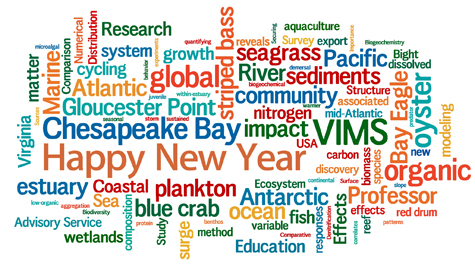VIMS Top 12 Stories from 2013
Take look back at this year’s top stories—from disappearing islands to plagued lobsters and the impact “dead zones” have on Chesapeake Bay fishes. The stories coming out of VIMS put a spotlight on our science and people, but it’s the stories coming out of news outlets around the world that also look to VIMS to enhance and inform their news. The following news articles garnered the most media mentions for the month in which they were published during 2013.
January 2013
January's most popular story, about the General Assembly's receipt of a report compiled by scientists at VIMS on coastal flooding in Virginia, garnered 23 out of the 93 media mentions for that entire month. Read the story here.
February 2013
February's most popular story, about a federal plan to restore the native oyster to Chesapeake Bay, garnered 7 out of 49 mentions from that month. Read the story here.
March 2013
March's most popular story, about rising tides threatening Jamestown Island, looked to VIMS Professor Emeritus Carl Hobbs to weigh in on the fate of the site of the first permanent English settlement in North America. That story garnered 32 out of the 160 mentions from that month. Read the story here.
April 2013
April's most read story, about a disappearing Tangier Island, garnered an impressive 119 media mentions out of the month’s total of 271 mentions. Read the story here.
May 2013
May's most-read story described a study led by VIMS researcher Lisa Kellogg showing that a restored oyster reef can remove up to 10 times more nitrogen from Chesapeake Bay waters than an unrestored area nearby. It garnered 58 out of 157 mentions. Read the story here.
June 2013
June's most-read story described the use of marine biodegradable bioplastics on fishing pots to reduce mortality rates of sea life. It garnered an impressive 152 out of 266 mentions. Read the story here.
July 2013
July’s most-read story described a 10-year study of Chesapeake Bay fishes by VIMS researchers that provides the first quantitative evidence on a bay-wide scale that low-oxygen "dead zones" are impacting the distribution and abundance of "demersal" fishes. That story received 21 out of 70 of the month’s media mentions. Read the story here.
August 2013
August’s most-read story describes a shell disease that has plagued the southern New England lobster industry for years and is now creeping towards Maine. That story received 186 out of 338 mentions. Read the story here.
September 2013
September’s most-read story describes research by graduate student Gina Ralph and colleagues showing that denser seagrass beds hold more baby blue crabs. That story received 13 out of 85 mentions. Read the story here.
October 2013
October’s most-read story describes the initial results from the VIMS Juvenile Striped Bass survey, which reports a rebound in juvenile striped bass numbers. That story received 20 out of 102 mentions. Read the story here.
November 2013
November’s most-read story describes a conference held to examine the threat climate-change poses to Virginia’s coastal communities, and referred to the “recurrent flooding” report released by VIMS’ Ms. Molly Mitchell and CCRM Director Carl Hershner. That story received 17 mentions. Read the story here.
December 2013
December’s most read story described rising sea levels in the coastal community of Norfolk, VA and also refers to the “recurrent flooding” study released in January 2013 that's co-authored by Carl Hershner and Molly Mitchell of VIMS. Read the story here.
We look forward to bringing you more news in 2014! Happy New Year from VIMS!


